Quick search
CTRL+K
Quick search
CTRL+K

Innsbruck is the capital of Tyrol and at the same time the fifth largest city in Austria. The town is wonderfully situated in the Inn River Valley with over 2,000 meters/6,500 feet high mountains rising to both the north and south. The nature and the city’s lovely atmosphere make it a good holiday destination both summer and winter.
The city center with pleasant streets is of course a must when in Innsbruck. This is where you will find the city’s most famous sight, the Golden Roof, which is a beautiful house from the year 1500. The city’s cathedral and the Kaiserliche Hofburg residence are other major sights.
Innsbruck’s location along the River Inn is beautiful, and you can enjoy some good walks in the city parks and not least in the mountains, which almost start in the middle of the city. To the north are the mountains in Nordkette, and it is easy to get to the heights with the Hungerburgbahn and the cable car to the top station Hafelekar.
The region around Innsbruck is characterized by mountains and a nice ski terrain in winter. In summer, the green surroundings with villages, hiking trails and lakes are of course also worth a trip. It is also not far to other city experiences, which are easily reached in Austria, Italy and Germany.
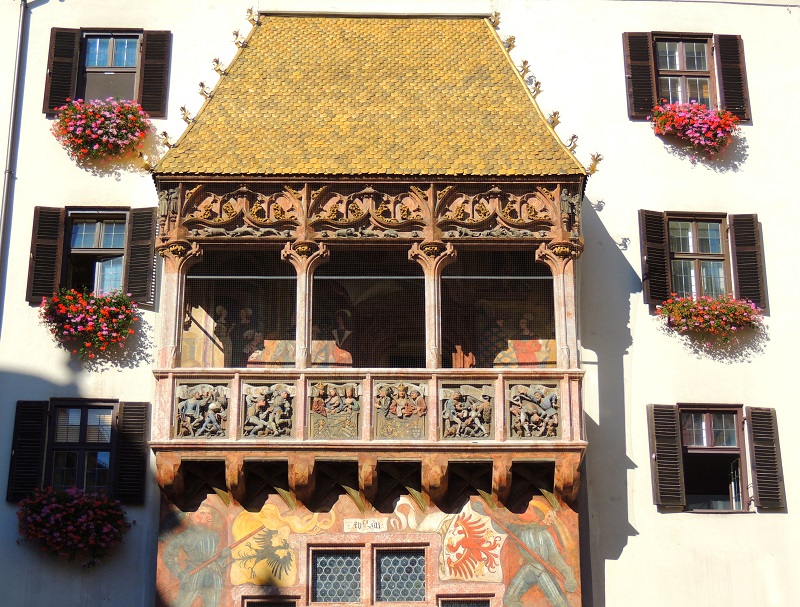
Goldenes Dachl is Innsbruck’s landmark and the most famous work in the street scene. The Golden Roof is located in the old town and was built in the year 1500 from 2,657 gilded copper plates to commemorate the wedding of Emperor Maximilian I with Biance Maria Sforza.
The imperial couple used the balcony under the Goldenes Dachl on special occasions, such as to attend various tournaments and festivals on the square below the balcony.
The entire overhang under the roof is decorated with sculptural reliefs and paintings. The balustrade on the first floor is adorned with eight coats of arms representing Maximilian’s territories at the time. Above the coats of arms you can see frescoes from the year 1500 by Jörg Kölderer, which show two knights with heraldic flags representing the Teutonic Roman Empire and Tyrol.
The balustrade on the second floor is decorated with reliefs depicting various images associated with Maximilian’s life. The two central reliefs show Maximilian with Bianca Maria Sforza and other people. The flanking reliefs show Moorish dancers dancing, which was a form of popular entertainment at the time.
The building bearing the Goldenes Dachl was built in the early 15th century by Archduke Friedrich IV. After this, it was Emperor Maximilian I who ordered the construction of the loggia in 1493. Today you can see the Golden Roof, and there is also a museum where you can experience more of the history of, among other things, the roof and Maximilian I.
Hofburg in Innsbruck was the residence of the imperial Habsburg family, and the castle is considered, together with the Hofburg and Schönbrunn in Vienna, to be the most important in the country. The Hofburg was originally built as a castle complex in the late medieval 15th century. It was rebuilt in the 18th century into the late Baroque era, and over time it became the seat of the Tyrolean counts and princes and residence of the Habsburgs until the end of the monarchy with the foundation of the Austrian Republic in 1918.
The current Hofburg is a result of the extensions that were made under Empress Maria Theresa by the court architect Johann Martin Gumpp the Younger in the transition between late baroque and rococo. After a break in construction from 1756 due to the Seven Years’ War, work was started again in 1766, and further expansion was carried out in 1766-70 by the military architect Konstantin Walter zu Pfeilsberg and the court architect Niccolò Pacassi from Vienna.
Maria Theresa sent her best artists to Innsbruck. This applied, for example, to Konstantin von Walter and Nicolaus Parcassi, while Martin van Meytens and his school and Franz Anton Maulbertsch were given the task of decorating the interior. The Empress herself was only in Innsbruck in 1739 and 1765, so she did not see the finished construction of the castle.
Today, the Hofburg is owned by the Austrian state, and you can visit the palace complex with its four building wings and the large courtyard. The large castle courtyard is accessed through the southern castle gate, and in the castle there are many highlights such as the Riesensaal. The Riesensaal is the largest representative hall in Hofbrug, and in the ballroom you can see portraits of Maria Theresia, her husband and her children. There is also a painting on the ceiling, which was created by the fresco artist Franz Anton Maulbertsch.
You can also see the imperial suites with the rooms Lothringerzimmer, Kapitelzimmer and Ferdinandszimmer, which are furnished with various furnishings from not least the last half of the 19th century. The memorial chapel Gedächtniskapelle Kaiser Franz I was where Maria Theresia’s husband Franz I. Stephan von Lothringen died in 1765. After that event, it was converted into a memorial chapel by Niccolò Pacassi.
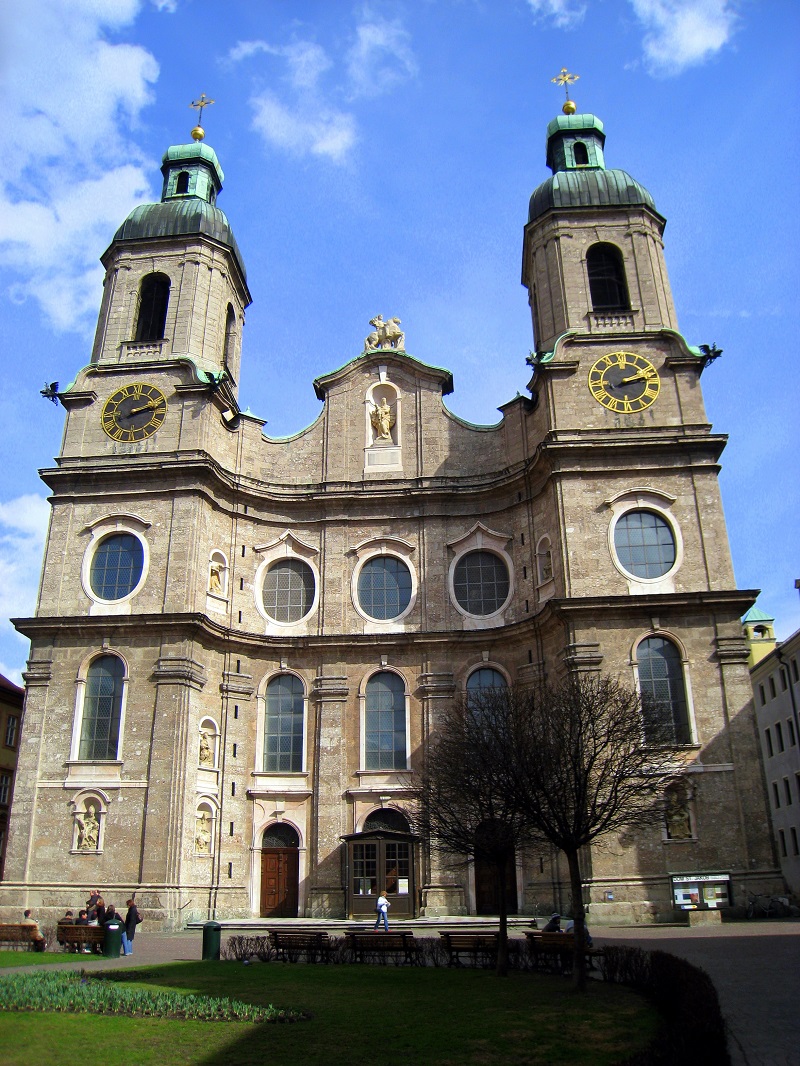
Dom zu St. Jakob is Innsbruck’s cathedral and a beautiful 18th-century church in baroque architecture. The cathedral was built 1717-1724 according to the drawings of the architect Johann Jakob Herkomer. It happened on the site where there used to be a Romanesque church from the 12th century. This church was both destroyed and rebuilt several times before it was decided to build the current cathedral.
The foundation stone for Johann Jakob Herkomer’s church was laid on 12 May 1717. The architect died in November of the same year, and Johann Georg Fischer, who was Herkomer’s nephew, continued the construction with only a few changes in the design. The church was consecrated in 1724, while work on the decoration of the interior continued until 1732.
The cathedral dominates Innsbruck’s skyline with its two bell towers and impressive dome. The double-towered facade faces west and Pfarrplatz. On the facade, you can see limestone statues of saints from Tyrol in the round-arched wall niches. The statues were created between 1941 and 1960 by Hans Andre, who also created the statue of the Virgin Mary in the gable and the equestrian statue of Saint James above it.
The interior of the cathedral is monumental, and the solid columns almost create a series of triumphal arches through the church space. The high dome gives light to the choir and leads the eye towards the high altar, which fills the entire width of the choir. This is precisely one of the effects that Johann Jakob Herkomer tried to create through an expansive interior with a spatial unity and harmony.
The decoration of the Dom zu St. Jacob is splendid and rich. The dominant frescoes were painted by Cosmas Damian Asam from Bavaria. Educated in Italy, Asam was the first South German artist to use the technique of optical illusion to project endless space, as he did in Innsbruck’s cathedral. Added to this is the stucco work, which was done by Asam’s younger brother, Egid Quirin Asam, and which reflects the visual form and color of the Renaissance with the support of the frescoes.
The cathedral has nine altars, of which the high altar is the primary one and also one of the highlights of the cathedral. The altar is flanked by statues of Saint Ingenuin and Saint Albuin, the patron saints of the episcopate of Brixen. The magnificent silver altar itself is one of the best examples of craftsmanship from Baroque Austria. The high altar also contains the painting Maria Hilf, which is the cathedral’s greatest treasure. Mary was painted by Lucas Cranach the Elder around the year 1530.
The Hofkirche is a Gothic church located next to the Hofburg imperial residence. The church and the adjoining Franciscan monastery were built in the years 1553-1563 by Emperor Ferdinand I, grandson of Emperor Maximilian I, which is an important detail, as the church was originally planned as the site of a grand imperial tomb for Maximilian I.
It was the architect Andrea Crivelli who designed the three-aisled hall church, on which Nikolaus Türing the Younger became the builder. Others also worked on the construction, such as Hieronymus de Longhi and Anton del Bon, who created the Renaissance portal to the Hofkirche. The high altar was built between 1755 and 1758 according to a design by the Viennese architect Nikolaus von Pacassi. It is flanked by the lead cast statues of St. Francis of Assisi and St. Teresa of Avila.
The interior of the church is dominated by the empty tomb of Emperor Maximilian I, around which there are 28 bronze figures. The tomb was commissioned by Maximilian I during his lifetime for the chapel of the castle in Wiener Neustadt, but it remained unfinished. It was Emperor Ferdinand I who had the magnificent tomb brought to Innsbruck and installed as a cenotaph in the court church he had built especially for it. The tomb in its present form was not completed until 1584, and the emperor remained buried in Wiener Neustadt.
You can also see the so-called silver chapel in the church, which Archduke Ferdinand II had built between 1577 and 1578 by court architect Hans Lucchese as a burial chapel for himself and his wife Philippine Welser, and it was extended in 1587. The chapel, named after the silver altar with a silver carved Madonna and her symbols, consists of two rooms separated by a lattice. In the chapel there are, among other things, two marble tombs.
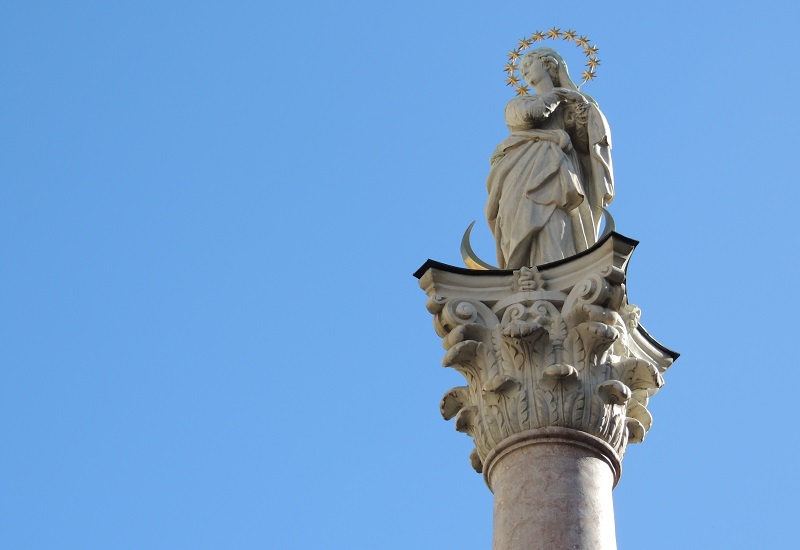
Annasäule is a monument that stands in Maria-Theresien-Straße in central Innsbruck. The column dates from 1704, when it was erected to celebrate the last Bavarian troops being driven out of Tyrol the year before. It happened on July 26, which is exactly St. Another name day.
The monument was created by the Trentino sculptor Cristoforo Benedetti from red marble with statues of four saints on the base: Anne, Cassian, Vigilius and Saint George with a dragon and a lance. At the top of the column and above the four saints is a statue of the Virgin Mary.
Altes Rathaus was Innsbruck’s former town hall. It stands on the street Herzog-Friedrich-Straße and was a town house that was bought by the city government in 1358 and used for Innsbruck’s administration. In the middle of the 15th century, the neighboring house was bought, and the Altes Rathaus functioned as the city’s town hall until 1897, when the current Neues Rathaus took over that role.
The town hall complex also contains the tower Stadtturm. It is a 56-meter high tower that was built around the year 1450. The tower originally had a pointed spire, but was given a Renaissance onion dome about 1560. It is the oldest such building in Austria, which was built according to Italian models.
In its day, the tower guard had to look for fires and enemies, and the Stadtturm had a function in that. Today there is a gallery at a height of 33 meters, which offers a fine view of the city’s rooftops.
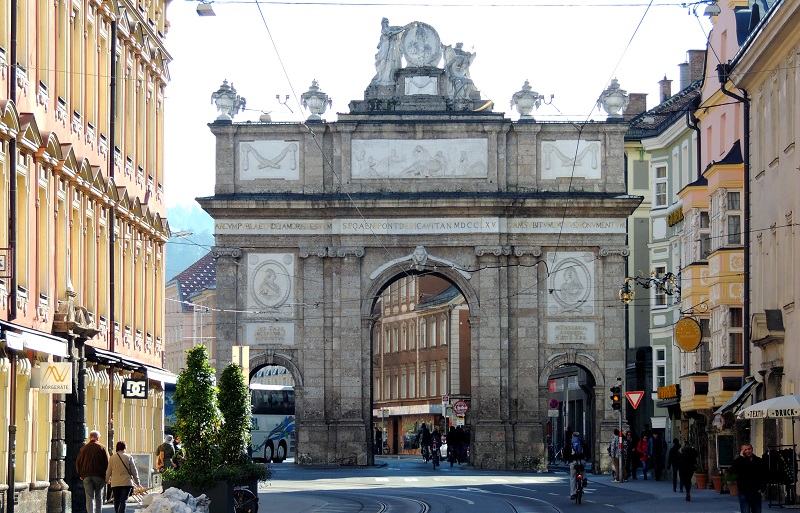
Triumphpforte is a triumphal arch that is one of Innsbruck’s best-known sights. The arch is located at the southern end of Maria-Theresien-Straße, and the site was formerly the southern entrance to the city. The relief decoration shows state symbols of the Habsburg monarchy as well as various personal and event-related motifs.
The Arc de Triomphe was built in 1765 on the occasion of the wedding between Archduke Leopold and the Spanish princess Maria Luisa. The south side of the arch therefore shows motifs related to the wedding of the young couple, while the north side refers to Emperor Leopold’s death, which occurred unexpectedly shortly after the wedding. In this way, the arch acquired a double-toned commemorative meaning.
Neues Rathaus is Innsbruck’s new town hall, and the city government has had its seat here since 1897. The history of the town hall building started as three Gothic town houses that were converted into the baroque Palais Künigl in the early 18th century. A merchant acquired the mansion in 1810, and in 1848 Ernst Manlik opened the place as the Hotel d’Autriche.
When the hotel was established, the facade was changed in a classicist style, but Manlik’s success did not last. The hotel closed in 1876, after which the house was bought by a grocer, who donated the mansion to the city as a new town hall in 1897. In 2002, a larger extension opened in modern design, which included shops in the passage RathausGalerien.
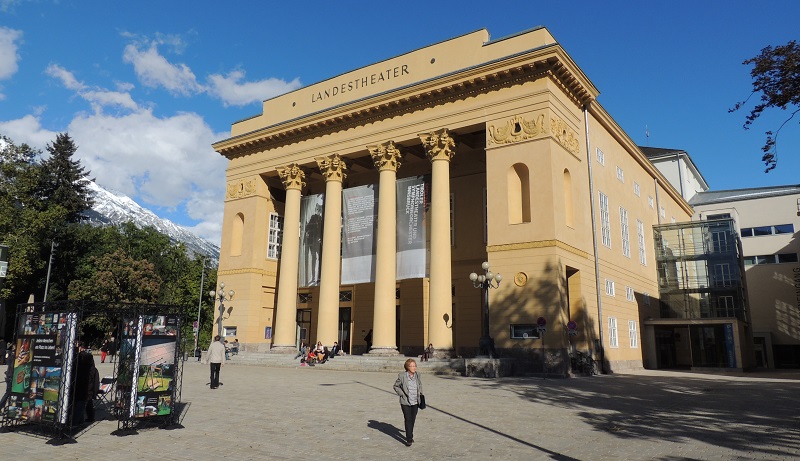
Tiroler Landestheater Innsbruck is the name of Tyrol’s state theatre, and the beautiful building has hosted countless performances and productions since its opening in 1846. The stage has had its current name since 1945.
However, there has been a playhouse in the town since 1629, when the architect Christopher Gump the Younger converted an existing house into a theater. In 1654, the same architect built an actual theater opposite where the Tiroler Landestheater Innsbruck stands today.
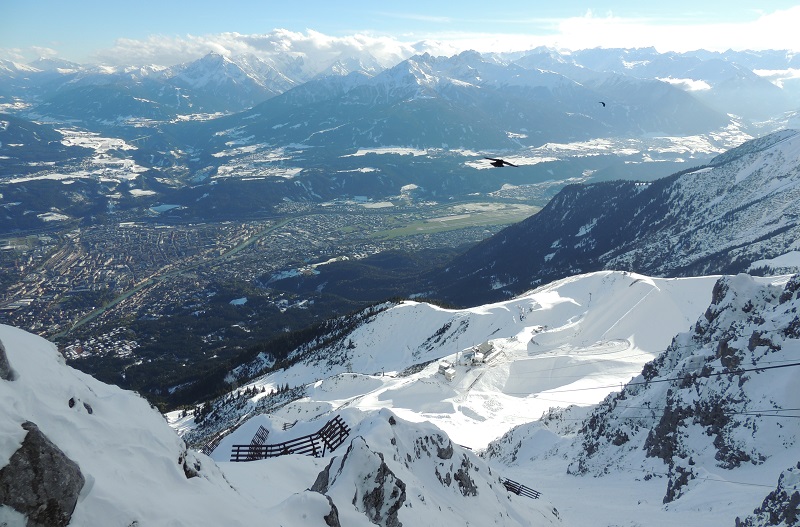
Nordkette is the name of the majestic mountain range that lies immediately north of Innsbruck. Nordkette is also called Inntalkette and is the southernmost part of the Karwendel mountain range, located in Austrian Tyrol and German Bavaria. The highest mountain in the Nordkette is the 2,637 meter high Kleine Solstein northwest of the center of Innsbruck.
The mountains around Innsbruck form a colossal recreational area, and the Nordkette is no exception. Almost the opposite, because it is easy to get to the top at Hafelekar at an altitude of 2,256 metres. The way there is with the Nordkettenbahn, which starts with the Hungerburgbahn and then with the cable car to the top, from where there is a fantastic view of the area’s mountains and over Innsbruck.
The trip to the top of the mountains starts at an altitude of 560 meters, where the Hungerburgbahn funicular begins. After a few stations on the way, you reach the terminus Hungerburg at an altitude of 860 meters. You can get off en route at the Alpenzoo station if you want a trip to Innsbruck’s interesting zoo.
From Hungerburg you can take the cable car to first Seegrube at an altitude of 1,905 meters and Hafelekar at an altitude of 2,256 meters. At Seegrube there are several pistes if you want to ski in season, and it is also possible from Hafelekar. From the top station you can simply enjoy the views or take a walk in the beautiful surroundings.

Schloß Ambras is a Renaissance castle that was built in the 16th century and is located at an altitude of 632 meters immediately south of Innsbruck. The castle was built in the 16th century and its historical significance is closely associated with Archduke Ferdinand II, as Schloß Ambras served as his family residence from 1567 to 1595.
Ferdinand II was a prominent art collector and he ordered the old medieval fortress at Ambras to be converted into a Renaissance castle as a gift for his wife. On that occasion, the complex’s lower castle (Unterschloss) was built as a museum to house the Archduke’s famous collections. The museum and Ferdinand’s collections still belong in the lower castle.
Between the lower and upper castles (Hochschloss) you can also see the famous Spanischer Saal, a beautiful hall and a remarkable example of German Renaissance architecture. The hall’s walls are adorned with 27 portraits of Tyrol’s rulers, and you can see a beautiful coffered ceiling in the hall, which was furnished 1569-1572 with a length of 43 meters and a width of 13 meters.
The upper castle contains the Habsburg Portrait Gallery with paintings of several members of Austrian royalty and other ruling European dynasties. The portraits were painted by artists such as Titian, Anthony van Dyck and Diego Velázquez. The castle is also worth seeing in itself with many beautiful building details in, among other things, the inner courtyard from 1564-1567. You can also see St. Nikolauskapelle, which is the castle’s chapel.
Finally, it is also worth enjoying the surroundings. The terrain slopes and offers natural rocks and green surroundings. In addition to that, an artificial waterfall was established, bridges were built and a castle park with different areas was arranged. The park was originally completed in 1574, and it housed fish ponds, bird aviaries, greenhouses, pleasure gardens and more.
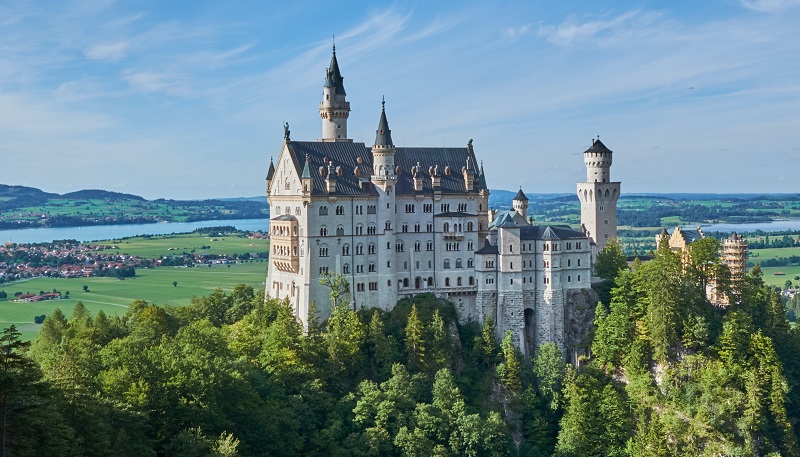
Schloß Neuschwanstein is one of Germany’s and the world’s most iconic castles. It was built at the foot of the Alps by King Ludwig II, who was also called the King of Adventures. Before the current castle, there was a castle here, and it lay in ruins until Ludwig II got the idea for Neuschwanstein. The idea was that the castle should be built as a castle from the time of the knights.
The castle was built from 1869, and it could be used in 1884. Ludwig II died two years later, and Neuschwanstein was not completely finished at this time. The missing parts were completed in a simplified design compared to the original plans.
Among the many exciting rooms in the castle, you can experience the 20×12 meter Throne Room. The model for the hall was the church Allerheiligen-Hofkirche from the Munich residence, and it is beautifully decorated with, for example, artwork in the apse. The Sangersalen/Sängersaal is the castle’s largest hall with dimensions of 27×10 metres. The prototypes are halls of the castle in the German Wartburg, and the decoration is based on themes of Lohengrin and Parzival.
From the outside, Neuschwanstein looks like a true fairytale castle with its towers and of course also the location on a mountain top with the Alps as a backdrop. The interior of the castle consists of an upper and a lower castle courtyard, surrounded by high and tower-adorned walls. At the end of the upper castle yard, the residence castle itself is located in the most prestigious place, and opposite the castle it was planned that a castle church should be built. On the pavement you can see the outline of the church that was never built.
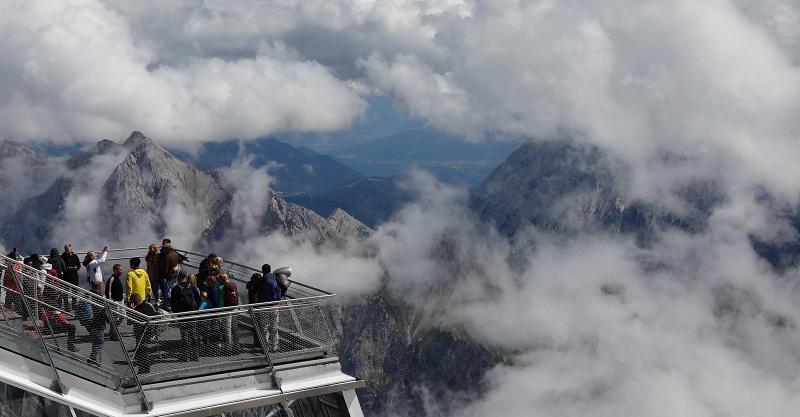
Zugspitze is Germany’s highest mountain at 2,962 metres, and unlike many other Alpine peaks, the Zugspitze is easily accessible to tourists. At the top itself there are three peaks, and here there is, among other things, a restaurant and a viewing terrace.
On the summit, since 1851, there has been a cross, the Zugspitzekreuz, which was erected during an expedition 11.-13. August. The initiator was the priest Christoph Ott, and his cross stood until a repair was necessary in 1881-1882. In 1993, the cross was taken down again for repairs, but after two months it was decided to put up a copy of the original cross.
The cross measures 4.88 meters in height and stands on the eastern peak of the Zugspitze, which is marginally higher than the other two peaks, which are the middle and the western. The western peak was 2,964 meters until, during Germany’s Nazi rule, some meters were blown away in order to establish an air traffic control center, which, however, was not built.
There are several routes to the top of the Zugspitze. From the city of Garmisch-Partenkirchen, it is easiest to take the Bayerische Zugspitzbahn cog railway from the railway station. The line runs, among other things, through a 4,466 meter long mountain tunnel up to the station Zugspitzblatt, which is located at an altitude of 2,588 metres.
From here, the Gletscherbahn cable car goes the last way up to the top of the Zugspitze itself. You can also get off the train in Eibsee at an altitude of 1,008 meters and take the Eibseeseilbahn cable car to the top of the Zugspitze; you can also choose a round trip where you combine the two transport routes. Both trips are totally worth it; both on the way up and of course also when standing on the mountaintop.
If you want to take the trip towards more mountains, the 2,628 meter high Alpspitze is nearby. Alpspitze’s pyramid-shaped peak is one of the area’s landmarks, and a 3,810-metre-long cable car goes up the mountain from 750 meters to the mountain station, located at 2,033 metres.

Kufstein is a cozy town in the Austrian Tyrol. The city is the second largest in the region after Innsbruck, and like other cities in the mountainous area, Kufstein is beautifully situated in nature and offers both history and fine sights. The town is known to be mentioned from 788, but its better-known history started in the 13th century, when the fortress Festung Kufstein was built. The castle was strategically important, as was Kufstein itself, which was a trading town with a river port.
The most famous building in today’s Kufstein is still the impressive fortress, which is located on a 90 meter high cliff at the top of the town. Therefore, you can see Festung Kufstein from a long distance. The castle is known from 1205, and it was later expanded several times. One of the corridors was in the 16th century, from which the Kaiserturm from 1518-1522 originates. Today you can visit the fortress, where they can be accessed, among other things, by the cable car Festungsbahn.
When you are in Kufstein you should also enjoy a stroll in the Altstadt, which is the name of the old town. Here you can see typical Tyrolean architecture in the narrow and cozy streets such as Römerhofgasse and Kirchgasse. Close to this, the river Inn runs through the city, and in the area you can also see Rathaus Kufstein, the city’s town hall. The oldest parts of the building date from the 16th century, while the gable was changed in the 1900s. Of the city’s churches, the Pfarrkirche Kufstein-St. Vitus particularly interesting. It was built 1390-1420 in Gothic style and rebuilt 1660-1661 in Baroque.
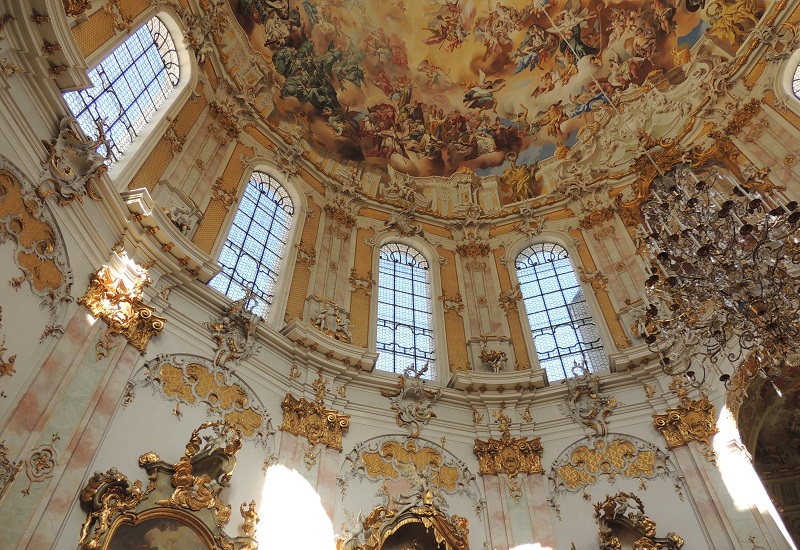
In the middle of the South German mountains is the village Ettal, which is home to a Benedictine monastery with a sumptuous abbey church. The monastery was founded on 28 April 1330 by Emperor Ludwig of Bavaria. The motives for the establishment have been partly development of the region and partly a form of imperial security and control of the trade route between Augsburg and Verona.
The monastery was active until a secularization closed the place in 1803. In 1900, Benedictine monks could move into the buildings again, and from 1907 it has again been an independent monastery with its own operations.
Today, the monastery runs many different businesses. This applies, among other things, to agriculture, accommodation and a brewery, located directly opposite the monastery complex.
The most beautiful part of the large monastery is the two-towered Mariæ Himmelfartskirke/Sankt Mariä Himmelfahrt Kirche, which in its original form dates back to the years 1330-1370, when a dodecagonal Gothic church was built. In the aftermath of the Reformation, the church was heavily damaged in 1552 after an attack by Elector Moritz von Sachsen’s troops, but it was only after a fire in 1744 that the current Baroque gem was built.
The church is located in a monastery courtyard and stands with an exterior with two towers and a large central dome beautiful with mountains as a backdrop. However, the fine exterior only becomes an unforgettable experience when you step inside. Here you are greeted by a wealth of decoration and details in elegant light shades. A highlight is Johann Jakob Zeiller’s ceiling fresco from 1746, and another is the organ built by Johann Georg Hörterich in 1768.

In the beautiful mountain valleys at the foot of the German Alps lies the small beautiful castle Linderhof, which was one of King Ludwig II’s residences. King Ludwig II also started the construction of two other castles in Bavaria, but Linderhof was the only one he got to see in its finished state.
When Ludwig II became king, he inherited Königshäuschen, which was located where the Linderhof is today. At first he wanted to expand the place, but he decided in 1874 to demolish the Königshäuschen and build the Linderhof.
The king himself had Linderhof built with the much larger Versailles near Paris as inspiration and model. His delight in the place is not least seen in the garden, which in addition to lakes and fountains has, among other things, an artificial stalactite cave.
The facility is very worth seeing, both as a castle with a castle garden, and also because of the location between the mountains, which almost tower right behind the castle complex, if normally only seen in other surroundings.
Amraser-See-Straße 56
dez.at
Maria-Theresien-Straße 31
kaufhaus-tyrol.at
Maria-Theresien-Straße 18
rathausgalerien.at
Museumstraße 38
sillpark.at
Maria-Theresien-Straße
Alpenzoo
Weiherburggasse 37a
alpenzoo.at
Nordkette
Rennweg 3
nordkette.com
Happyhopp
Mooswinkl 7, Vomp
happyhopp.at
Swarovski Kristallwelten
Wattens
kristallwelten.swarovski.com
Hallenbad Olympisches Dorf
Kugelfangweg 46
ikb.at

Innsbruck, AustriaOverview of Innsbruck
Innsbruck is the capital of Tyrol and at the same time the fifth largest city in Austria. The town is wonderfully situated in the Inn River Valley with over 2,000 meters/6,500 feet high mountains rising to both the north and south. The nature and the city’s lovely atmosphere make it a good holiday destination both summer and winter.
The city center with pleasant streets is of course a must when in Innsbruck. This is where you will find the city’s most famous sight, the Golden Roof, which is a beautiful house from the year 1500. The city’s cathedral and the Kaiserliche Hofburg residence are other major sights.
Innsbruck’s location along the River Inn is beautiful, and you can enjoy some good walks in the city parks and not least in the mountains, which almost start in the middle of the city. To the north are the mountains in Nordkette, and it is easy to get to the heights with the Hungerburgbahn and the cable car to the top station Hafelekar.
About the Whitehorse travel guide
Contents: Tours in the city + tours in the surrounding area
Published: Released soon
Author: Stig Albeck
Publisher: Vamados.com
Language: English
About the travel guide
The Whitehorse travel guide gives you an overview of the sights and activities of the Canadian city. Read about top sights and other sights, and get a tour guide with tour suggestions and detailed descriptions of all the city’s most important churches, monuments, mansions, museums, etc.
Whitehorse is waiting for you, and at vamados.com you can also find cheap flights and great deals on hotels for your trip. You just select your travel dates and then you get flight and accommodation suggestions in and around the city.
Read more about Whitehorse and Canada
Canada Travel Guide: https://vamados.com/canada
City tourism: https://visitwhite-horse.ca
Main Page: https://www.vamados.com/
Buy the travel guide
Click the “Add to Cart” button to purchase the travel guide. After that you will come to the payment, where you enter the purchase and payment information. Upon payment of the travel guide, you will immediately receive a receipt with a link to download your purchase. You can download the travel guide immediately or use the download link in the email later.
Use the travel guide
When you buy the travel guide to Whitehorse you get the book online so you can have it on your phone, tablet or computer – and of course you can choose to print it. Use the maps and tour suggestions and you will have a good and content-rich journey.


Annasäule is a monument that stands in Maria-Theresien-Straße in central Innsbruck. The column dates from 1704, when it was erected to celebrate the last Bavarian troops being driven out of Tyrol the year before. It happened on July 26, which is exactly St. Another name day.
The monument was created by the Trentino sculptor Cristoforo Benedetti from red marble with statues of four saints on the base: Anne, Cassian, Vigilius and Saint George with a dragon and a lance. At the top of the column and above the four saints is a statue of the Virgin Mary.
Altes Rathaus was Innsbruck’s former town hall. It stands on the street Herzog-Friedrich-Straße and was a town house that was bought by the city government in 1358 and used for Innsbruck’s administration. In the middle of the 15th century, the neighboring house was bought, and the Altes Rathaus functioned as the city’s town hall until 1897, when the current Neues Rathaus took over that role.
The town hall complex also contains the tower Stadtturm. It is a 56-meter high tower that was built around the year 1450. The tower originally had a pointed spire, but was given a Renaissance onion dome about 1560. It is the oldest such building in Austria, which was built according to Italian models.
In its day, the tower guard had to look for fires and enemies, and the Stadtturm had a function in that. Today there is a gallery at a height of 33 meters, which offers a fine view of the city’s rooftops.

Triumphpforte is a triumphal arch that is one of Innsbruck’s best-known sights. The arch is located at the southern end of Maria-Theresien-Straße, and the site was formerly the southern entrance to the city. The relief decoration shows state symbols of the Habsburg monarchy as well as various personal and event-related motifs.
The Arc de Triomphe was built in 1765 on the occasion of the wedding between Archduke Leopold and the Spanish princess Maria Luisa. The south side of the arch therefore shows motifs related to the wedding of the young couple, while the north side refers to Emperor Leopold’s death, which occurred unexpectedly shortly after the wedding. In this way, the arch acquired a double-toned commemorative meaning.
Neues Rathaus is Innsbruck’s new town hall, and the city government has had its seat here since 1897. The history of the town hall building started as three Gothic town houses that were converted into the baroque Palais Künigl in the early 18th century. A merchant acquired the mansion in 1810, and in 1848 Ernst Manlik opened the place as the Hotel d’Autriche.
When the hotel was established, the facade was changed in a classicist style, but Manlik’s success did not last. The hotel closed in 1876, after which the house was bought by a grocer, who donated the mansion to the city as a new town hall in 1897. In 2002, a larger extension opened in modern design, which included shops in the passage RathausGalerien.

Tiroler Landestheater Innsbruck is the name of Tyrol’s state theatre, and the beautiful building has hosted countless performances and productions since its opening in 1846. The stage has had its current name since 1945.
However, there has been a playhouse in the town since 1629, when the architect Christopher Gump the Younger converted an existing house into a theater. In 1654, the same architect built an actual theater opposite where the Tiroler Landestheater Innsbruck stands today.
Similar to Innsbruck Travel Guide
